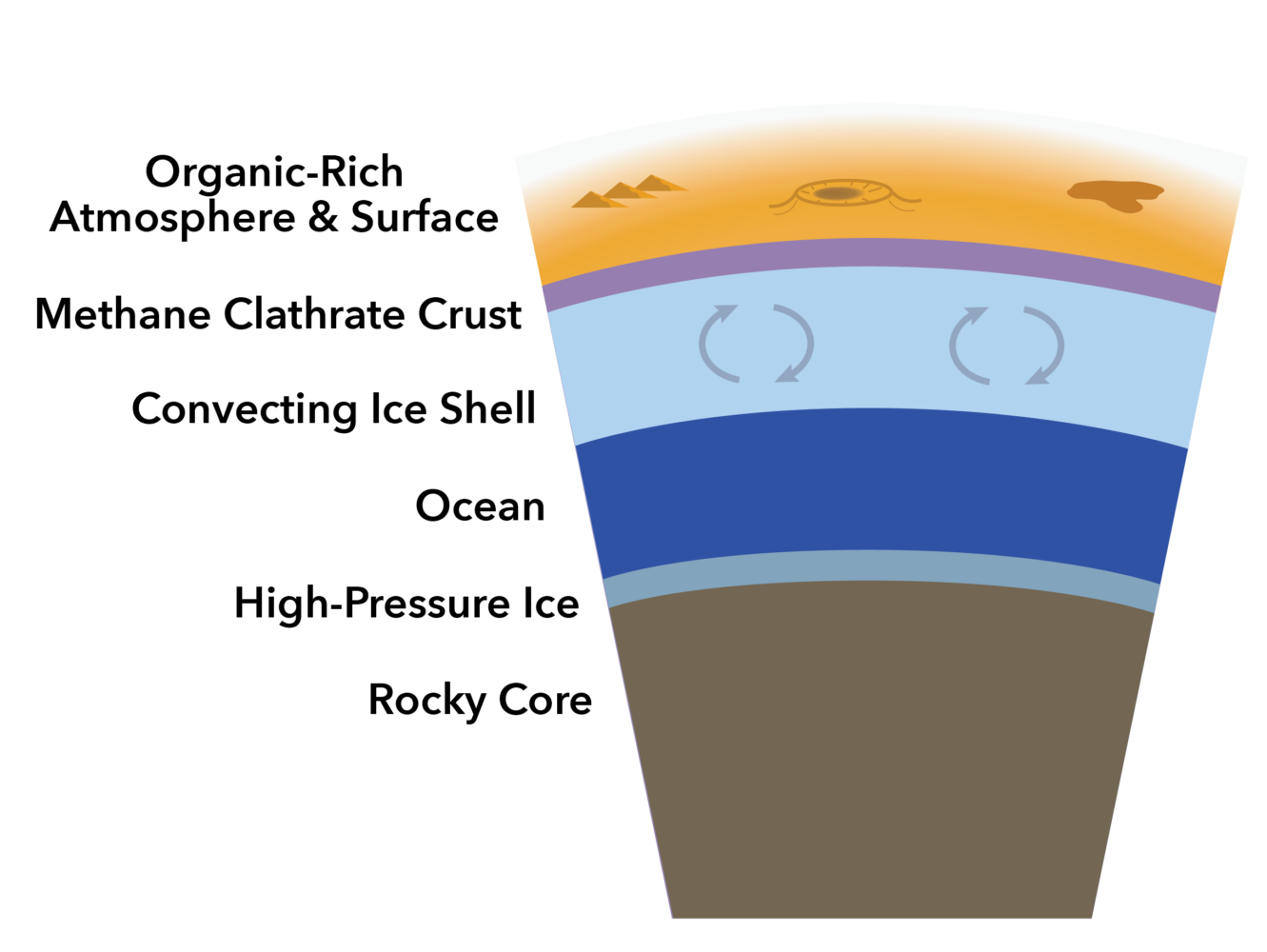Scientists have found that the icy shell of Saturn’s largest moon, Titan, might possess an insulated, six-mile-thick (9.7-kilometer-thick) layer of methane ice beneath its floor. Sarcastically, this layer might make indicators of life from the subsurface ocean of Titan simpler to detect. And, down the road, the invention may gain advantage the combat in opposition to human-driven local weather change on Earth.
Titan could also be a moon, however additionally it is extra just like Earth than another photo voltaic system planet. That is as a result of it’s the solely planet or moon within the photo voltaic system apart from Earth to own an environment in addition to liquid rivers, lakes and seas. Due to the frigid temperatures of Titan, nonetheless, this liquid consists of hydrocarbons like methane and ethane. Nonetheless, the floor ice of Titan is certainly composed of water.
The brand new outcomes from a group of planetary scientists on the College of Hawaii at Mānoa revealed that methane gasoline might also be trapped inside Titan’s ice shell, forming a definite crust as much as six miles thick. This gasoline might heat the underlying ice shell and assist molecules rise to the floor of Titan, a few of which might point out the presence of life. This warming might also assist clarify Titan’s methane-rich environment.
“If life exists in Titan’s ocean beneath the thick ice shell, any indicators of life, biomarkers, would must be transported up Titan’s ice shell to the place we might extra simply entry or view them with future missions,” analysis group chief and College of Hawaii scientist Lauren Schurmeier stated in a press release. “That is extra prone to happen if Titan’s ice shell is heat and connecting.”
The group was first tipped off to the potential existence of this connecting layer of methane ice by the presence of shallow impression craters on Titan. Solely 90 impression craters have been seen on the floor of the Saturnian moon, and these have been complicated to watch as a result of they ought to be lots of of ft deeper than they really are.
“This was very stunning as a result of, primarily based on different moons, we anticipate to see many extra impression craters on the floor and craters which are a lot deeper than what we observe on Titan,” Schurmeier stated. “We realized one thing distinctive to Titan have to be making them turn into shallower and disappear comparatively rapidly.”
Investigating Titan’s shallow craters
To additional delve into the thriller of Titans’ swallow impression craters, Schurmeier and colleagues turned to pc modeling. This allowed them to check how a lot the floor of Saturn’s largest moon would calm down and rebound after an asteroid impression if its icy shell have been coated with an insulating layer of methane clathrate.
Methane clathrate, or “methane hydrate,” is a strong compound through which a considerable amount of methane is trapped inside the crystalline construction of water, making a strong just like ice.
Contemplating craters of comparable measurement on an icy moon of Jupiter that is similar to Titan, Ganymede, the researchers might evaluate doable depths of impression craters on the Saturnian moon.
“Utilizing this modeling strategy, we have been in a position to constrain the methane clathrate crust thickness to 5 to 10 kilometers [about three to six miles] as a result of simulations utilizing that thickness produced crater depths that finest matched the noticed craters,” added Schurmeier. “The methane clathrate crust warms Titan’s inside and causes surprisingly fast topographic rest, which leads to crater shallowing at a charge that’s near that of fast-moving heat glaciers on Earth.”
The thickness of this methane icy shell issues as a result of it might finally clarify why Titan’s environment is especially wealthy with this hydrocarbon. It might additionally assist scientists higher perceive Titan’s carbon cycle, its liquid methane-based “hydrological cycle,” and the altering local weather of the Saturnian moon.
“Titan is a pure laboratory to check how the greenhouse gasoline methane warms and cycles by means of the environment,” Schurmeier defined. “Earth’s methane clathrate hydrates, discovered within the permafrost of Siberia and under the arctic seafloor, are presently destabilizing and releasing methane.
“So, classes from Titan can present necessary insights into processes taking place on Earth.”

The thickness of the methane clathrate crust, when seen within the gentle of the topography of Titan, signifies that the Saturnian moon’s inside is probably going heat and versatile quite than chilly and inflexible, as as soon as believed.
“Methane clathrate is stronger and extra insulating than common water ice,” Schurmeier added. “A clathrate crust insulates Titan’s inside, makes the water ice shell very heat and ductile, and implies that Titan’s ice shell is or was slowly convecting.”
And that convection signifies that biomarkers indicating life might have been hoisted from Titan’s subsurface ocean and carried to its outer icy shell, simply awaiting discovery.
This analysis might act as a useful information to NASA scientists who intend to analyze Titan utilizing the forthcoming Dragonfly spacecraft. Dragonfly is ready to launch in 2028 and hopefully attain the Saturnian system in 2034 to conduct up-close observations of Titan’s icy floor.
The group’s analysis was revealed on Sept. 30 in The Planetary Science Journal.





